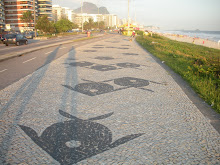Interesting Excerpt from: A new approach of innovative design: an introduction to CK theory by A Hatchuel, B Weil.
4.1.How can we validate a design theory?
It seems to us that the validation of a design theory is similar to the validation of other theories like decision theory or problem solving theory. In all these cases three criteria can be used. Each of them is probably not enough, however taken together they can be more convincing. i) First criteria: the theory constitutes a good unification of previous theories about the same object. ii) Second criteria : the theory clarifies hidden properties of its object that were not visible in the previous theories and this new insight contributes to embed the theory in a more universal body of knowledge. iii)Third criteria: the theory clarifies some pragmatic issues and even offers new ways to treat them with robust expectations.
Tuesday, March 31, 2009
Thursday, February 12, 2009
Saturday, December 6, 2008
Thursday, August 28, 2008
Java with generics..
Programming in Java without generics feels like juggling with a bunch of greasy balls.
Wednesday, January 23, 2008
Monday, January 21, 2008
Mysticism of Creativity
The more I study creativity, the more the magic of it begins to melt away. When I first started reading about creativity, I thought of it like pulling things that don't exist out of the air, and somehow give birth to a new concept. I saw exercises for improving creativity as a mystic ritual people did to summon ideas from a netherworld. The process always seemed magical.
Now, creativity just seems like a way creating connections between what we already know, or reframing things we already know with a different perspective. I'm feeling like creativity is a process that can be forced on anyone. I can completely see creativity being built into AI once a sense of semantics is built into an AI engine.
Now, creativity just seems like a way creating connections between what we already know, or reframing things we already know with a different perspective. I'm feeling like creativity is a process that can be forced on anyone. I can completely see creativity being built into AI once a sense of semantics is built into an AI engine.
Sunday, December 16, 2007
Tip of the tongue phenomenon
Feature idea - what if Calico used speech recognition to map words that were said while something was being drawn? It wouldn't have to be accurate in the least. If only a few words can be captured, it would key people in to what was being discussed. For example, after a discussion is done, you could use a lasso that would circle a set of figures, and a list of words that were mentioned while those were being drawn appeared in a transient floating box. It wouldn't necessarily be sentences, just key words. The speech recognition software could have a high error rate, even 50 percent miss, but it would still be extremely useful. It would need to be calibrated, test if the gap would need to be only while it's being drawn, or if it needs everything said 1 minute before and after. It could also be calibrated to pick out "important" words, or all words. This could be done retroactively by assigning a time stamp to all drawn objects, and a time stamp to all words recorded, then map them to each other afterwards.
What makes this useful and possible is the tip of the tongue phenomenon. People are much better at recognition than they are at recall. While reviewing a session, the words would be similar enough that they would instigate a recognition of events. A psych study was done on tip of the tongue events, and people recited items which were either close phonetically or semantically. So, even if the voice recognition software completely butchered the word, it would be close enough that it clue the reviewer to an idea that was at the tip of their tongue.
I would like to perform a study eventually using Calico and this concept. The study would involve two sessions, one session using the board, and one session a few days later that reviewed the first session to allow an incubation process for ideas. The latter test would involve questions reviewing the first drawing session, having them look at key words, and measure how many new ideas are spawned by looking at the old. Also, a search feature would send the user to elements drawn that included that key word.
I don't want to develop this feature myself, but if another person joins the team, I'd like have them work on this.
Reference 1
Reference 2
Reference 3
What makes this useful and possible is the tip of the tongue phenomenon. People are much better at recognition than they are at recall. While reviewing a session, the words would be similar enough that they would instigate a recognition of events. A psych study was done on tip of the tongue events, and people recited items which were either close phonetically or semantically. So, even if the voice recognition software completely butchered the word, it would be close enough that it clue the reviewer to an idea that was at the tip of their tongue.
I would like to perform a study eventually using Calico and this concept. The study would involve two sessions, one session using the board, and one session a few days later that reviewed the first session to allow an incubation process for ideas. The latter test would involve questions reviewing the first drawing session, having them look at key words, and measure how many new ideas are spawned by looking at the old. Also, a search feature would send the user to elements drawn that included that key word.
I don't want to develop this feature myself, but if another person joins the team, I'd like have them work on this.
Reference 1
Reference 2
Reference 3
Subscribe to:
Comments (Atom)

